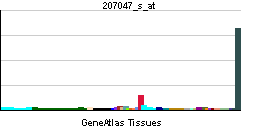CLCNKA
| Chloride channel Ka | |||||||||||
|---|---|---|---|---|---|---|---|---|---|---|---|
| Identifiers | |||||||||||
| Symbols | CLCNKA ; CLCK1; ClC-K1; MGC61490; hClC-Ka | ||||||||||
| External IDs | Template:OMIM5 Template:MGI HomoloGene: 65 | ||||||||||
| |||||||||||
| RNA expression pattern | |||||||||||
 | |||||||||||
| More reference expression data | |||||||||||
| Orthologs | |||||||||||
| Template:GNF Ortholog box | |||||||||||
| Species | Human | Mouse | |||||||||
| Entrez | n/a | n/a | |||||||||
| Ensembl | n/a | n/a | |||||||||
| UniProt | n/a | n/a | |||||||||
| RefSeq (mRNA) | n/a | n/a | |||||||||
| RefSeq (protein) | n/a | n/a | |||||||||
| Location (UCSC) | n/a | n/a | |||||||||
| PubMed search | n/a | n/a | |||||||||
Chloride channel Ka, also known as CLCNKA, is a human gene.[1]
This gene is a member of the CLC family of voltage-gated chloride channels. The encoded protein is predicted to have 12 transmembrane domains, and requires a beta subunit called barttin to form a functional channel. It is thought to function in salt reabsorption in the kidney and potassium recycling in the inner ear. The gene is highly similar to CLCNKB, which is located 10 kb downstream from this gene. Multiple transcript variants encoding different isoforms have been found for this gene.[1]
References
Further reading
- Jentsch TJ, Günther W (1997). "Chloride channels: an emerging molecular picture". Bioessays. 19 (2): 117–26. doi:10.1002/bies.950190206. PMID 9046241.
- Kieferle S, Fong P, Bens M; et al. (1994). "Two highly homologous members of the ClC chloride channel family in both rat and human kidney". Proc. Natl. Acad. Sci. U.S.A. 91 (15): 6943–7. PMID 8041726.
- Maruyama K, Sugano S (1994). "Oligo-capping: a simple method to replace the cap structure of eukaryotic mRNAs with oligoribonucleotides". Gene. 138 (1–2): 171–4. PMID 8125298.
- Takeuchi Y, Uchida S, Marumo F, Sasaki S (1996). "Cloning, tissue distribution, and intrarenal localization of ClC chloride channels in human kidney". Kidney Int. 48 (5): 1497–503. PMID 8544406.
- Saito-Ohara F, Uchida S, Takeuchi Y; et al. (1997). "Assignment of the genes encoding the human chloride channels, CLCNKA and CLCNKB, to 1p36 and of CLCN3 to 4q32-q33 by in situ hybridization". Genomics. 36 (2): 372–4. doi:10.1006/geno.1996.0479. PMID 8812470.
- Suzuki Y, Yoshitomo-Nakagawa K, Maruyama K; et al. (1997). "Construction and characterization of a full length-enriched and a 5'-end-enriched cDNA library". Gene. 200 (1–2): 149–56. PMID 9373149.
- Estévez R, Boettger T, Stein V; et al. (2002). "Barttin is a Cl- channel beta-subunit crucial for renal Cl- reabsorption and inner ear K+ secretion". Nature. 414 (6863): 558–61. doi:10.1038/35107099. PMID 11734858.
- Strausberg RL, Feingold EA, Grouse LH; et al. (2003). "Generation and initial analysis of more than 15,000 full-length human and mouse cDNA sequences". Proc. Natl. Acad. Sci. U.S.A. 99 (26): 16899–903. doi:10.1073/pnas.242603899. PMID 12477932.
- Schlingmann KP, Konrad M, Jeck N; et al. (2004). "Salt wasting and deafness resulting from mutations in two chloride channels". N. Engl. J. Med. 350 (13): 1314–9. doi:10.1056/NEJMoa032843. PMID 15044642.
- Gerhard DS, Wagner L, Feingold EA; et al. (2004). "The status, quality, and expansion of the NIH full-length cDNA project: the Mammalian Gene Collection (MGC)". Genome Res. 14 (10B): 2121–7. doi:10.1101/gr.2596504. PMID 15489334.
- Scholl U, Hebeisen S, Janssen AG; et al. (2006). "Barttin modulates trafficking and function of ClC-K channels". Proc. Natl. Acad. Sci. U.S.A. 103 (30): 11411–6. doi:10.1073/pnas.0601631103. PMID 16849430.
- Olsen JV, Blagoev B, Gnad F; et al. (2006). "Global, in vivo, and site-specific phosphorylation dynamics in signaling networks". Cell. 127 (3): 635–48. doi:10.1016/j.cell.2006.09.026. PMID 17081983.
- Barlassina C, Dal Fiume C, Lanzani C; et al. (2007). "Common genetic variants and haplotypes in renal CLCNKA gene are associated to salt-sensitive hypertension". Hum. Mol. Genet. 16 (13): 1630–8. doi:10.1093/hmg/ddm112. PMID 17510212.
- Markovic S, Dutzler R (2007). "The structure of the cytoplasmic domain of the chloride channel ClC-Ka reveals a conserved interaction interface". Structure. 15 (6): 715–25. doi:10.1016/j.str.2007.04.013. PMID 17562318.
| This protein-related article is a stub. You can help Wikipedia by expanding it. |